- 1Institut für Kernphysik, Technische Universität Darmstadt, Darmstadt, Germany
- 2Norwegian Nuclear Research Center and Department of Physics, University of Oslo, Oslo, Norway
- 3Research Center for Nuclear Physics, University of Osaka, Ibaraki, Japan
We review the experimental knowledge on the dipole polarizability (DP) of nuclei and its relation to the neutron skin thickness and properties of the neutron-rich matter equation of state (EOS). The discussion focuses on recent experiments using relativistic Coulomb excitation in inelastic proton scattering at extreme forward angles covering a mass range from 40Ca to 208Pb. Constraints on the neutron skins and the density dependence of the symmetry energy are derived from a systematic comparison to calculations based on density functional theory (DFT) and ab initio methods utilizing interactions derived from chiral effective field theory (
1 Introduction
The nuclear equation of state (EOS) describes the energy per nucleon of nuclear matter as a function of proton
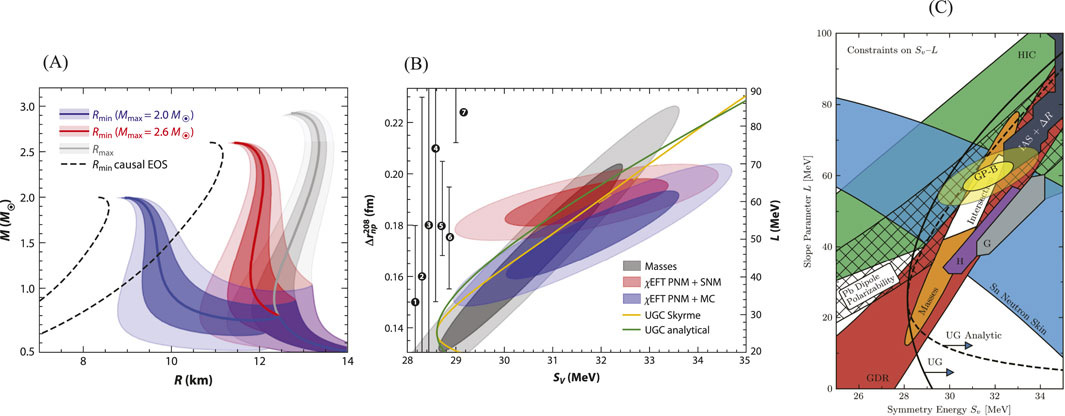
Figure 1. (A) Predictions of the mass–radius relation of neutron stars from different EOS. Figure taken from [3]. (B) Theoretical constraints on the relation of
The nuclear matter EOS can be approximately written as a sum of the energy per nucleon of symmetric matter and an asymmetry term
where the nucleon density
The symmetry energy factor
Here,
The first term in Equation 1 representing symmetric nuclear matter is fairly well constrained by the compressibility derived from systematic measurements of the isoscalar giant monopole resonance (ISGMR) in nuclei [1]. Figures 1B,C [3, 10] illustrate the variety of experimental and theoretical constraints on
As detailed below, all relevant theoretical models predict a strong correlation between
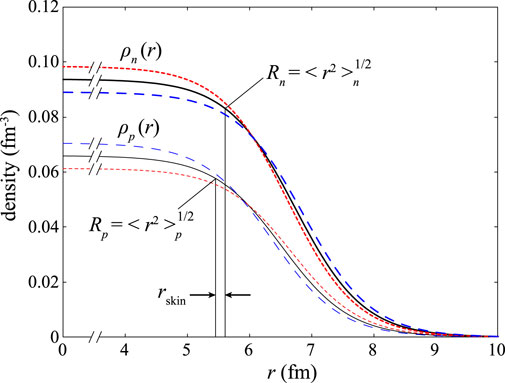
Figure 2. Neutron and proton density distributions are schematically shown by the thick and thin solid lines, respectively. For a larger (smaller)
The neutron skin thickness is sensitive to the
The neutron skin thicknesses of medium-mass and heavy nuclei have been extracted from experiments studying elastic proton scattering [11], coherent
The dipole polarizability (DP) of nuclei can be obtained from measurements of the photoabsorption cross-sections. A connection between DP, neutron skin thickness, and parameters of the symmetry energy can only be made through models. Such calculations are presently based either on density functional theory (DFT) [20] or ab initio coupled-cluster calculations [21] using interactions derived from
While several experimental techniques to measure the DP are discussed, the present review mainly focuses on recent progress using relativistic Coulomb excitation in forward-angle proton scattering at energies of several hundred MeV [24]. One advantage of this method is consistent results across the neutron separation energy, while many of the other experimental techniques are limited to either the energy region below or above. Even more important, measurements of the
The paper is organized as follows. Section 2 discusses how information on the neutron skin thickness and symmetry energy can be inferred from model calculations based on DFT (Section 2.1) and ab initio methods (Section 2.2). Section 3 is devoted to experimental issues. A short discussion of the available techniques in Section 3.1 is followed by a description of methods to disentangle electric and magnetic contributions to the DP in Section 3.2. The relevance of experimental information in the energy region of the isovector giant dipole resonance (IVGDR), as well as below the neutron threshold and above the IVGDR, is compared in Section 3.3, Section 3.4, and Section 3.5. The comparison of experimental and theoretical results (Section 4) for a range of nuclei from 40Ca to 208Pb and constraints on neutron skin thickness and the parameters of the symmetry energy extracted thereof are presented in Section 4.1 for DFT and Section 4.2 for ab initio approaches. Section 4.3 focuses on the difficulties of simultaneously describing the results of parity-violating elastic electron scattering and DP experiments with present-day models. Finally, Section 4.4 discusses the systematics of the DP and the role of volume and surface contributions to the symmetry energy. A summary and an outlook are given in Section 5.
2 Relation between dipole polarizability, neutron skin thickness, and symmetry energy
In this section, we discuss how information on the neutron skin thickness and parameters of the symmetry energy can be inferred from the comparison of the experimental dipole polarizability to theoretical predictions. At the moment, there are two classes of models, based on either DFT or an ab initio coupled-cluster approach. Because isovector observables are not well constrained in DFT, quantitative predictions of the DP can vary considerably. However, one can establish a robust correlation between the parameters
The dipole polarizability
While the integral runs to infinity in principle, because of the inverse energy weighting a measurement of the
2.1 Connections in density functional theory
An approximately linear correlation between
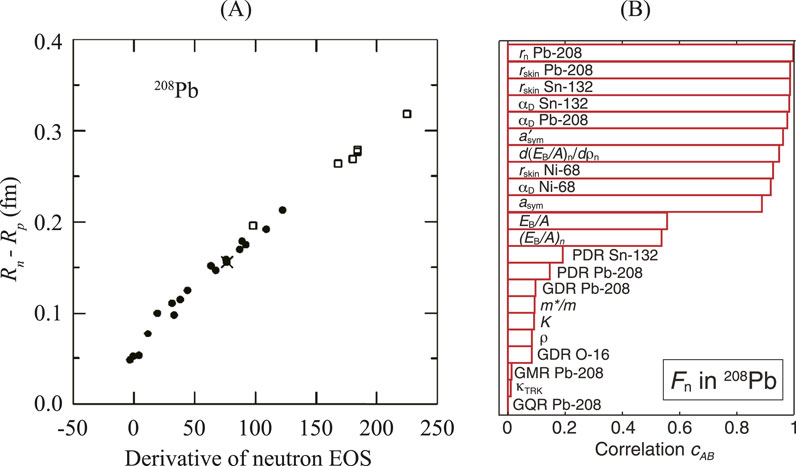
Figure 3. (A) Correlation between the neutron skin thickness in 208Pb and
While this type of correlation is observed for all interactions, absolute values show large differences. In general, the magnitude of IV quantities like
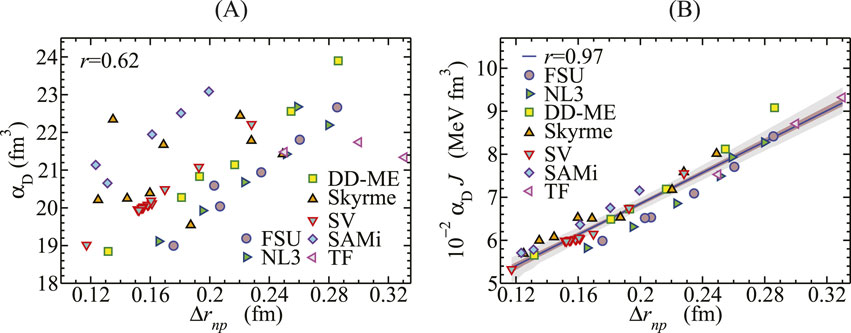
Figure 4. (A) Dipole polarizability against neutron skin thickness in 208Pb Pb predicted by modern DFT interactions. (B) The same for dipole polarizability times symmetry energy at saturation density. The results are well described by a linear fit. Figures taken from [34], where the original references for the various interactions can be found.
2.2 Connections in ab initio models
Ab initio calculations based on interactions derived from
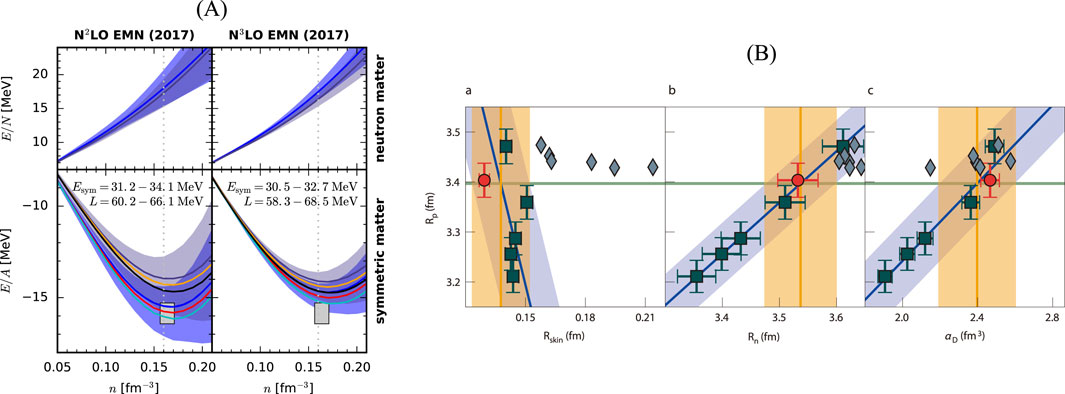
Figure 5. (A) Energy per particle in neutron matter (top row) and symmetric nuclear matter (bottom row) based on chiral interactions at
Predictions of
A major difference between the two theoretical approaches lies in the predicted relation between the proton and neutron radii. The DFT predictions of
3 Dipole polarizability from experiment
In this section, we discuss the experimental methods to extract the
3.1 Experimental methods
3.1.1 Photoneutron measurement
The photoexcitation of nuclei above the neutron separation energy was intensively studied by using photoneutron measurements. The photoneutron reaction is conventionally written as
Neutron emission is the dominant decay process after photoexcitation for a nucleus as heavy as 208
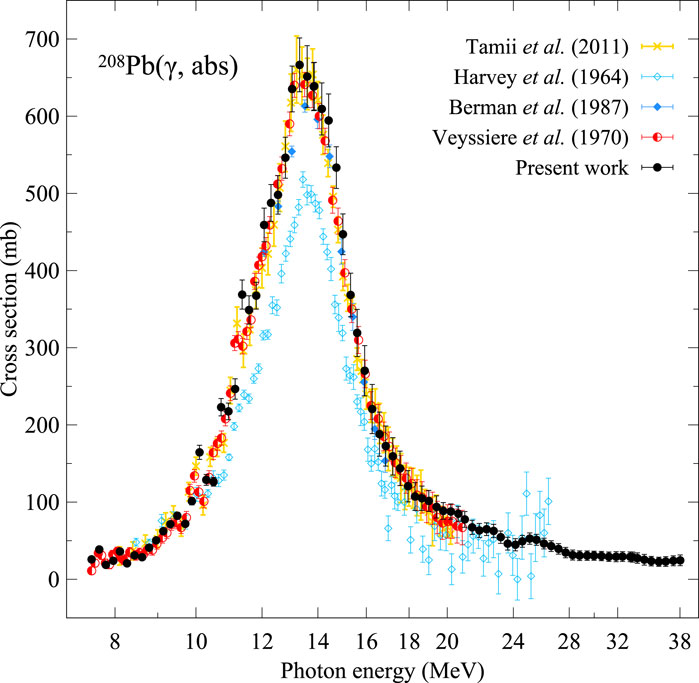
Figure 6. Comparison of the photoabsorption cross-sections of 208Pb from different experiments. Figure taken from [53], where the original references can be found.
Later, quasi-monoenergetic photon beams produced by laser Compton backscattering (LCBS) became available at the National Institute of Advanced Industrial Science and Technology (AIST) [54], the High Intensity
3.1.2 Total photoabsorption
Total photon absorption was studied by applying transmission measurements. In this method, the attenuation of photons in a thick target was measured as a function of the photon energy for extraction of the photoabsorption cross sections. At the Mainz electron accelerator, a narrow photon beam was produced by the bremsstrahlung of an electron beam. The average photon flux was
3.1.3 Compton scattering
Compton scattering from 208
3.1.4 Bremsstrahlung excitation functions
Photonuclear cross sections have been extracted from the radioactive decay of residual nuclei populated in particle emission after irradiation with thick-target bremsstrahlung. The excitation energy dependence can be determined by variation of the bremsstrahlung endpoint energy with an unfolding procedure [62]. However, this requires precise knowledge of the bremsstrahlung spectra, which is experimentally not available. While such spectra can be reliably calculated [63] with present-day Monte Carlo codes such as GEANT4 [64], older versions contained poor approximations [65]. Results deduced from phenomenological approximations or using the analytical description of thin-target bremsstrahlung have potentially very large systematic uncertainties, typically not included in the quoted errors.
3.1.5 Relativistic Coulomb excitation
Relativistic Coulomb excitation is an important experimental tool to study the electric dipole response at radioactive ion beam (RIB) facilities. At beam energies of several hundred MeV/nucleon, cross sections are large and cover an excitation energy range including the IVGDR. The small number of beam particles can be compensated for neutron-rich nuclei by placing a neutron detector under
The method has also been developed to study stable nuclei using inelastic proton scattering under extreme forward angles, including
3.1.6 Nuclear resonance fluorescence
Nuclear resonance fluorescence (NRF) or
3.2 Decomposition of
A general problem of all experimental methods discussed above is the removal of magnetic contributions to the photoabsorption cross sections and the derived DP. Overall, contributions of
No
In relativistic Coulomb excitation, the virtual photon spectrum in the forward direction is dominated by
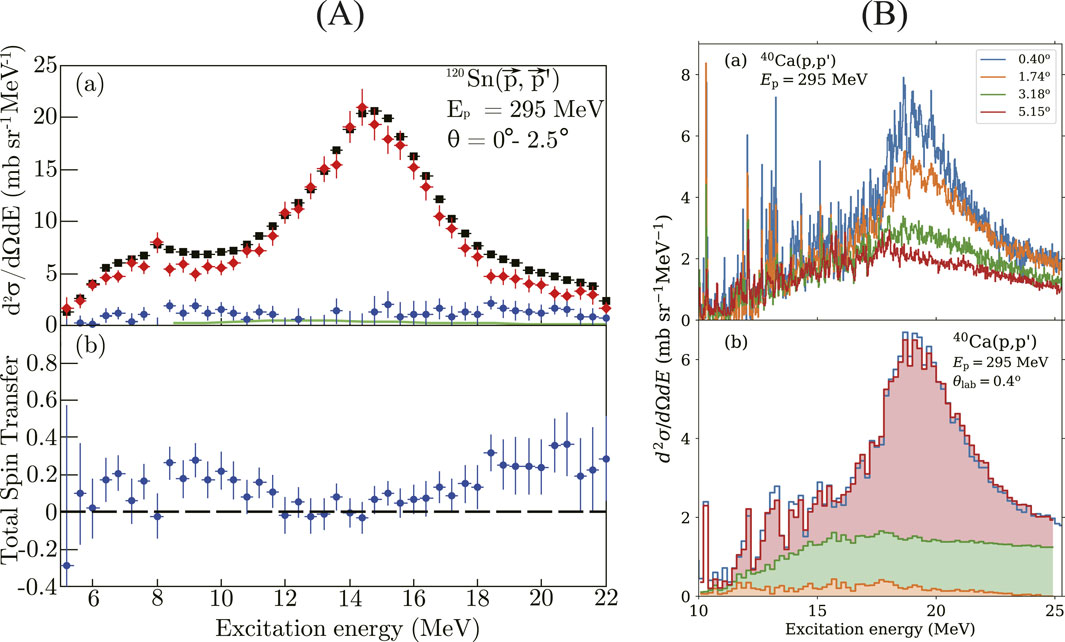
Figure 7. (A) Top: Double differential cross sections of the 120Sn
An example of the MDA analysis is presented in Figure 7B for 40Ca [29]. Spectra at different scattering angles are displayed in the upper panel, demonstrating strongly forward-peaked cross sections in the energy region of the IVGDR expected for Coulomb excitation. The lower panel shows the partial contributions to the cross sections at the most forward angle measured resulting from the MDA:
3.3 Contributions from the IVGDR
The largest contribution to the DP stems from the IVGDR, whose energy centroids lie well above

Figure 8. Comparison of photoabsorption cross sections from different experiments. (A)
The
In general, studies of the
3.4 Contributions from the PDR
All particle-emission coincidence experiments accessing the
Most data on low-energy
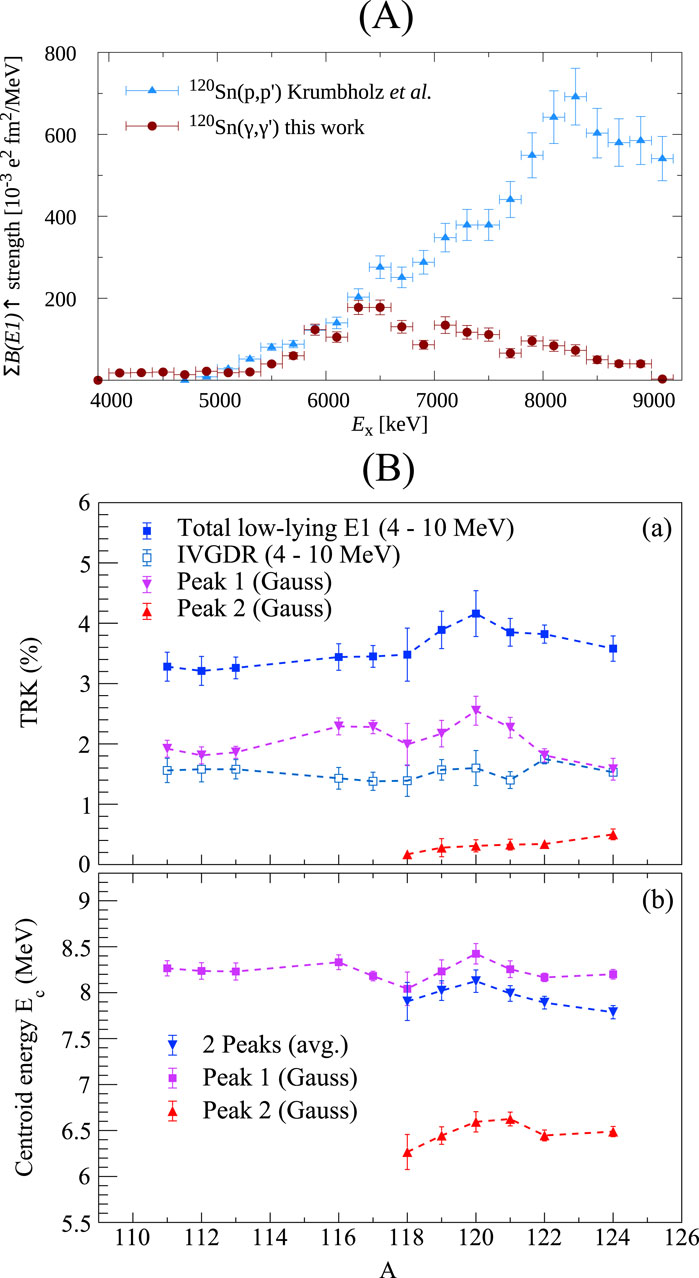
Figure 9. (A) Comparison of
The origin of the low-energy
3.5 Contributions from high excitation energies
At excitation energies beyond the giant resonance region, photonuclear cross sections typically contribute a few percent only to the DP. However, for precision results, they must be considered. Data up to the pion threshold have been measured for a few cases, viz., natCa [58], natSn [104], and 208Pb [61, 51]. They show approximately constant cross sections as a function of excitation energy and were considered for the extraction of the DP from
The ratio of Coulomb excitation to quasifree cross sections in the
4 Extracting neutron skin thickness and symmetry energy properties from dipole polarizability data
In this section, we discuss constraints on the neutron skin thickness and symmetry energy properties derived from the comparison between model predictions and experimental studies of the DP. These refer to specific nuclei like 40Ca, 48Ca, and 208Pb but also systematic isotopic trends or a global mass dependence. The difficulties that presently available models have in simultaneously accounting for measured polarizabilities and asymmetries in parity-violating elastic electron scattering are illuminated.
4.1 Constraints based on density functional theory
The DPs of 40Ca and 48Ca have been studied in [29, 78], respectively. Figure 10A depicts their correlation and a comparison to selected DFT results. The four functionals are representative of widely used forms: non-relativistic Skyrme functionals SV [111] and RD [112] with different forms of density dependence, and relativistic functionals DD [113] with finite-range meson-exchange coupling and PC [114] with point coupling. All four have been calibrated to the same set of ground-state data to determine the model parameters.
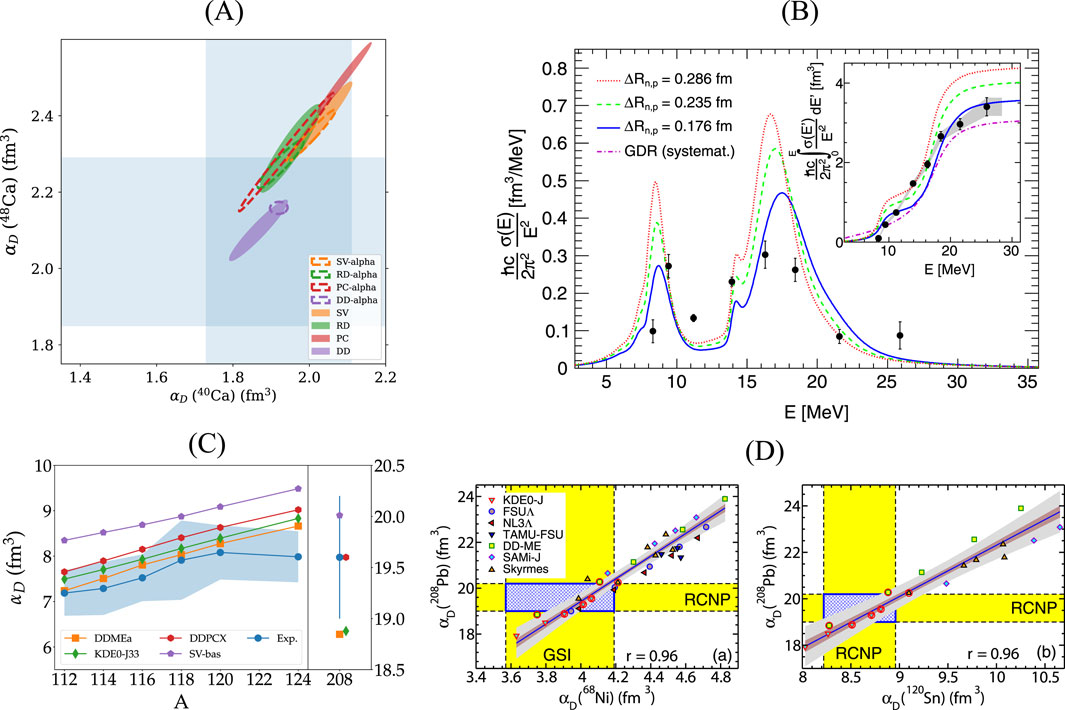
Figure 10. (A) Correlation of the experimental DP of 40Ca and 48Ca (blue bands) in comparison with DFT calculations without (full ellipses) and with (dashed ellipses) inclusion of the experimental DP of 208Pb [36] in the parameter fit. (B)
The predictions are displayed as filled ellipses that represent the
The
A study of the DP in a long isotopic chain is particularly suited to investigate the connection with the neutron skin thickness. This can be best done in the Sn isotopes with neutron numbers between 50 and 82, where the proton shell closure stabilizes the g.s. deformation. There are many stable isotopes, and a study of the systematics of the DP was presented in [79]. The results are summarized in Figure 10C, which shows the evolution of
Roca-Maza et al. [106] combined the experimental DP data for 68Ni [26], 120Sn [30], and 208Pb [36] to test a large variety of density functionals. Because the DFT calculations do not include contributions from the quasi-deuteron process dominating the photoabsorption cross sections above the energy region of the IVGDR, these had to be removed for a comparison [106]. Figure 10D presents correlation plots between the experimental results and theoretical predictions from a wide range of DFT interactions. Only a handful (marked in red) are capable of simultaneously describing all three data points. Based on this reduced set, systematic predictions of
4.2 Constraints based on ab initio models
An experimental study of the DP in 48Ca [78] is of particular interest because it is accessible for both DFT and ab initio calculations, and a measurement of the neutron skin with parity-violating electron scattering is available [19]. The comparison is summarized in Figure 11A, where the blue band describes the experimental uncertainty. Ab initio results for the set of interactions from [38, 39] are displayed as green triangles, and a prediction from [40] based on a normalization to the 48Ca charge radius is displayed as a green bar. Results from the set of density functionals described in [40] are shown as red squares with some representative error bars, and the prediction from the analysis of [106] discussed above is shown as a black bar.

Figure 11. (A) Experimental DP in 48Ca (blue band) and predictions from ab initio results based on
The DFT results tend to be somewhat high compared to the experiment. The ab initio results show a significant dependence on the chosen interaction, but it can be well approximated by a linear dependence. In principle, this allows for the derivation of boundaries on the neutron skin thickness and the symmetry energy. However, while the ab initio results shown were truncated in the coupled-cluster expansion at the 2p-2h level, subsequent work [118] demonstrated that inclusion of 3p-3h correlations lowers the
As noted in Section 2.2, independent of the chosen interaction, a neutron skin thickness of approximately 0.14 fm is predicted for 48Ca, consistent with the value deduced from the measurement of the weak form factor [19]. The simultaneous description of the data in 40,48Ca and 68Ni implies that the underlying symmetry energy parameters are correct. A conservative estimate is provided by taking the full range of values from the set of ab initio interactions, viz.,
Recent work has, for the first time, been able to extend the range of ab initio DP calculations based on
4.3 Tension between polarizability and parity-violating elastic electron scattering in 208Pb
While in 48Ca there is fair agreement between the neutron skin thickness and symmetry energy properties derived from the different experiments, the parity-violating elastic electron scattering experiment on 208Pb [18] finds a much larger neutron skin
Because of the strong correlation between
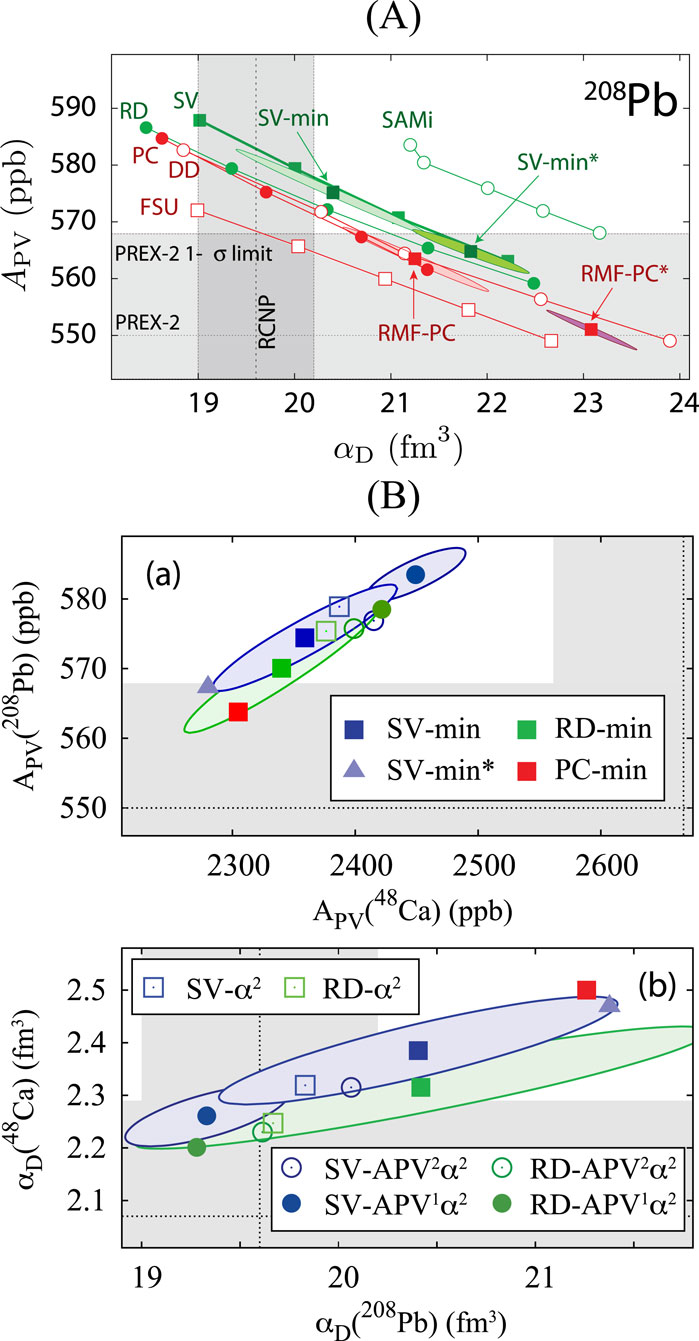
Figure 12. (A) Experimental parity-violating asymmetry versus DP in 208Pb (gray bands) compared to calculations with a set of relativistic (red) and non-relativistic (green) DFT interactions. Sets with systematically varied symmetry energy
4.4 Volume and surface contributions to the symmetry energy
Another way of extracting properties of the symmetry energy is a study of the mass dependence of the DP. A simple power law
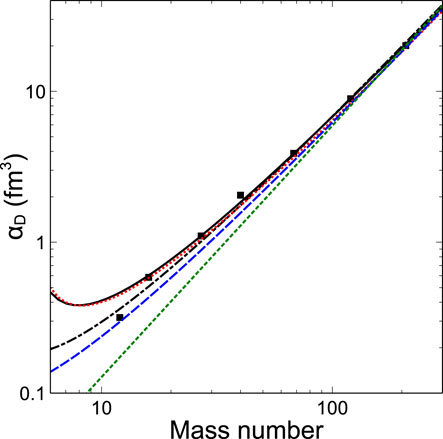
Figure 13. Experimental DP for a set of nuclei as a function of mass number (full squares). The green and blue lines are fits with the original Migdal model (Equations 1, 2) in [127]. The black lines are fits of Equation 5 allowing for a surface term of the symmetry energy, including (dashed-dotted) and excluding (full) the data point for 12C. The red line shows a fit with the prediction of [129] using the “
For masses
Here
5 Conclusion and outlook
We present a review of methods to measure the isovector
Constraints on the neutron skin thickness of nuclei and the parameters of the symmetry energy can be extracted from the strong correlations between these three quantities seen in all microscopic models. Results from nuclei covering a mass range between 40Ca and 208Pb consistently favor small neutron skins and a soft density dependence of the EOS around saturation density. In 208Pb serving as a benchmark for theory, this finding is at variance with the PREX results, while a similar study of 48Ca by the CREX collaboration conforms. The PREX result, hard to interpret in the framework of present theory, has led to an initiative (called Mainz radius experiment, or MREX) for a study with improved statistical and systematic errors at the new high-current Mainz energy-recovering superconducting accelerator (MESA) [132].
While the mass dependence of the DP is reasonably well-covered by the available data, future work should explore other degrees of freedom, such as the variation of neutron excess along isotopic chains and the role of deformation. The experimental uncertainties of the DP for key nuclei can be improved by the availability of independent measurements, as illustrated in Figure 6. New high-brilliance LCBS photon beam facilities are under construction at the Extreme Light Infrastructure–Nuclear Physics (ELI-NP) in Bucharest [133, 134] and the Shanghai Laser Electron Gamma Source (SLEGS) at the Shanghai Synchrotron Radiation Facility [135]. Combined with advanced techniques for neutron detection [136], these facilities promise a new quality of precision for
Major steps can be expected in the future at radioactive ion beam facilities, providing access to cases with much larger neutron excess than achievable for stable nuclei. Experimental tools for measuring relativistic Coulomb excitation in reverse kinematics are available, and pioneering studies of the dipole response in unstable nuclei have been performed at GSI [25, 26, 27]. First results for the neutron-rich isotope 52Ca investigated at RIKEN have been reported [137]. Because of the high energy/nucleon availability, future experiments at FAIR are particularly promising for research on the dipole polarizability of exotic neutron-rich nuclei [138].
Author contributions
PN-C: writing – original draft and writing – review and editing. AT: writing – original draft and writing – review and editing.
Funding
The author(s) declare that financial support was received for the research and/or publication of this article. This work was supported by the Deutsche Forschungsgemeinschaft (DFG, German Research Foundation) under Contract No. SFB 1245 (Project ID No. 79384907), by the Research Council of Norway through its grant to the Norwegian Nuclear Research Centre (Project No. 341985), by the JSPS KAKENHI Grant Number 25H00641, and by the Japan-South Africa Bilateral Funding Grant Number JPJSBP 120246502.
Acknowledgments
PvNC thanks the nuclear physics group at the University of Oslo for their kind hospitality during a stay where major parts of this work were done.
Conflict of interest
The authors declare that the research was conducted in the absence of any commercial or financial relationships that could be construed as a potential conflict of interest.
Generative AI statement
The author(s) declare that no Generative AI was used in the creation of this manuscript.
Publisher’s note
All claims expressed in this article are solely those of the authors and do not necessarily represent those of their affiliated organizations, or those of the publisher, the editors and the reviewers. Any product that may be evaluated in this article, or claim that may be made by its manufacturer, is not guaranteed or endorsed by the publisher.
References
1. Roca-Maza X, Paar N. Nuclear equation of state from ground and collective excited state properties of nuclei. Prog Part Nucl Phys (2018) 101:96–176. doi:10.1016/j.ppnp.2018.04.001
2. Huth S, Pang PTH, Tews I, Dietrich T, Le Fèvre A, Schwenk A, et al. Constraining neutron-star matter with microscopic and macroscopic collisions. Nature (2022) 606:276–80. doi:10.1038/s41586-022-04750-w
3. Lattimer J. Neutron stars and the nuclear matter equation of state. Annu Rev Nucl Part Sci (2021) 71:433–64. doi:10.1146/annurev-nucl-102419-124827
4. Yasin H, Schäfer S, Arcones A, Schwenk A. Equation of state effects in core-collapse supernovae. Phys Rev Lett (2020) 124:092701. doi:10.1103/PhysRevLett.124.092701
5. Raaijmakers G, Greif SK, Hebeler K, Hinderer T, Nissanke S, Schwenk A, et al. Constraints on the dense matter equation of state and neutron star properties from NICER’s mass–radius estimate of PSR J0740+6620 and multimessenger observations. Astrophys J Lett (2021) 918:L29. doi:10.3847/2041-8213/ac089a
6. Koehn H, Rose H, Pang PTH, Somasundaram R, Reed BT, Tews I, et al. From existing and new nuclear and astrophysical constraints to stringent limits on the equation of state of neutron-rich dense matter. Phys Rev X (2025) 15:021014. doi:10.1103/PhysRevX.15.021014
7. Lattimer J. Constraints on nuclear symmetry energy parameters. Particles (2023) 6:30–56. doi:10.3390/particles6010003
8. Estee J, Lynch WG, Tsang CY, Barney J, Jhang G, Tsang MB, et al. Probing the symmetry energy with the spectral pion ratio. Phys Rev Lett (2021) 126:162701. doi:10.1103/PhysRevLett.126.162701
9. Tsang MB, Stone JR, Camera F, Danielewicz P, Gandolfi S, Hebeler K, et al. Constraints on the symmetry energy and neutron skins from experiments and theory. Phys Rev C (2012) 86:015803. doi:10.1103/PhysRevC.86.015803
10. Drischler C, Furnstahl RJ, Melendez JA, Phillips DR. How well do we know the neutron-matter equation of state at the densities inside neutron stars? A Bayesian approach with correlated uncertainties. Phys Rev Lett (2020) 125:202702. doi:10.1103/PhysRevLett.125.202702
11. Zenihiro J, Sakaguchi H, Murakami T, Yosoi M, Yasuda Y, Terashima S, et al. Neutron density distributions of 204,206,208Pb deduced via proton elastic scattering at Ep = 295 MeV. Phys Rev C (2010) 82:044611. doi:10.1103/physrevc.82.044611
12. Tarbert CM, Watts DP, Glazier DI, Aguar P, Ahrens J, Annand JRM, et al. Neutron skin of 208Pb from coherent pion photoproduction. Phys Rev Lett (2014) 112:242502. doi:10.1103/PhysRevLett.112.242502
13. Kłos B, Trzcińska A, Jastrzebski J, Czosnyka T, Kisieliński M, Lubiński P, et al. Neutron density distributions from antiprotonic 208Pb and 209Bi atoms. Phys Rev C (2007) 76:014311. doi:10.1103/PhysRevC.76.014311
14. Trzcińska A, Jastrzȩbski J, Lubiński P, Hartmann FJ, Schmidt R, von Egidy T, et al. Neutron density distributions deduced from antiprotonic atoms. Phys Rev Lett (2001) 87:082501. doi:10.1103/PhysRevLett.87.082501
15. Krasznahorkay A, Fujiwara M, van Aarle P, Akimune H, Daito I, Fujimura H, et al. Excitation of isovector spin-dipole resonances and neutron skin of nuclei. Phys Rev Lett (1999) 82:3216–9. doi:10.1103/PhysRevLett.82.3216
16. Mammei JM, Horowitz CJ, Piekarewicz J, Reed BT, Sfienti C. Neutron skins: weak elastic scattering and neutron stars. Annu Rev Nucl Part Sci (2024) 74:321–42. doi:10.1146/annurev-nucl-102122-024207
17. Horowitz CJ, Pollock SJ, Souder PA, Michaels R. Parity violating measurements of neutron densities. Phys Rev C (2001) 63:025501. doi:10.1103/PhysRevC.63.025501
18. Adhikari D, Albataineh H, Androic D, Aniol K, Armstrong DS, Averett T, et al. Accurate determination of the neutron skin thickness of 208Pb through parity-violation in electron scattering. Phys Rev Lett (2021) 126:172502. doi:10.1103/PhysRevLett.126.172502
19. Adhikari D, Albataineh H, Androic D, Aniol KA, Armstrong DS, Averett T, et al. Precision determination of the neutral weak form factor of 48Ca. Phys Rev Lett (2022) 129:042501. doi:10.1103/PhysRevLett.129.042501
20. Bender M, Heenen P-H, Reinhard P-G. Self-consistent mean-field models for nuclear structure. Rev Mod Phys (2003) 75:121–80. doi:10.1103/RevModPhys.75.121
21. Hagen G, Papenbrock T, Hjorth-Jensen M, Dean D. Coupled-cluster computations of atomic nuclei. Rep Prog Phys (2014) 77:096302. doi:10.1088/0034-4885/77/9/096302
22. Epelbaum E, Hammer H-W, Meißner U-G. Modern theory of nuclear forces. Rev Mod Phys (2009) 81:1773–825. doi:10.1103/RevModPhys.81.1773
23. Thiel M, Sfienti C, Piekarewicz J, Horowitz CJ, Vanderhaeghen M. Neutron skins of atomic nuclei: per aspera ad astra. J Phys G (2019) 46:093003. doi:10.1088/1361-6471/ab2c6d
24. von Neumann-Cosel P, Tamii A (2019). Electric and magnetic dipole modes in high-resolution inelastic proton scattering at 0°. Eur Phys J A 55, 110. doi:10.1140/epja/i2019-12781-7
25. Adrich P, Klimkiewicz A, Fallot M, Boretzky K, Aumann T, Cortina-Gil D, et al. Evidence for pygmy and giant dipole resonances in 130Sn and 132Sn. Phys Rev Lett (2005) 95:132501. doi:10.1103/PhysRevLett.95.132501
26. Rossi DM, Adrich P, Aksouh F, Alvarez-Pol H, Aumann T, Benlliure J, et al. Measurement of the dipole polarizability of the unstable neutron-rich nucleus 68Ni. Phys Rev Lett (2013) 111:242503. doi:10.1103/PhysRevLett.111.242503
27. Wieland O, Bracco A, Camera F, Benzoni G, Blasi N, Brambilla S, et al. Search for the pygmy dipole resonance in 68Ni at 600 MeV/nucleon. Phys Rev Lett (2009) 102:092502. doi:10.1103/PhysRevLett.102.092502
28. Aumann T, Bartmann W, Boine-Frankenheim O, Bouvard A, Broche A, Butin F, et al. PUMA, antiproton unstable matter annihilation. Eur Phys J A (2022) 58:88. doi:10.1140/epja/s10050-022-00713-x
29. Fearick RW, von Neumann-Cosel P, Bacca S, Birkhan J, Bonaiti F, Brandherm I, et al. Electric dipole polarizability of 40Ca. Phys Rev Res (2023) 5:L022044. doi:10.1103/PhysRevResearch.5.L022044
30. Hashimoto T, Krumbholz AM, Reinhard P-G, Tamii A, von Neumann-Cosel P, Adachi T, et al. Dipole polarizability of 120Sn and nuclear energy density functionals. Phys Rev C (2015) 92:031305. doi:10.1103/PhysRevC.92.031305
31. Typel S, Brown BA. Neutron radii and the neutron equation of state in relativistic models. Phys Rev C (2001) 64:027302. doi:10.1103/PhysRevC.64.027302
32. Brown BA. Neutron radii in nuclei and the neutron equation of state. Phys Rev Lett (2000) 85:5296–9. doi:10.1103/PhysRevLett.85.5296
33. Reinhard P-G, Nazarewicz W. Information content of a new observable: the case of the nuclear neutron skin. Phys Rev C (2010) 81:051303. doi:10.1103/PhysRevC.81.051303
34. Roca-Maza X, Brenna M, Colò G, Centelles M, Viñas X, Agrawal BK, et al. Electric dipole polarizability in 208Pb: insights from the droplet model. Phys Rev C (2013) 88:024316. doi:10.1103/PhysRevC.88.024316
35. Myers W, Swiatecki W. The nuclear droplet model for arbitrary shapes. Ann Phys (N.Y.) (1974) 84:186–210. doi:10.1016/0003-4916(74)90299-1
36. Tamii A, Poltoratska I, von Neumann-Cosel P, Fujita Y, Adachi T, Bertulani CA, et al. Complete electric dipole response and the neutron skin in 208Pb. Phys Rev Lett (2011) 107:062502. doi:10.1103/PhysRevLett.107.062502
37. Drischler C, Hebeler K, Schwenk A. Chiral interactions up to next-to-next-to-next-to-leading order and nuclear saturation. Phys Rev Lett (2019) 122:042501. doi:10.1103/PhysRevLett.122.042501
38. Ekström A, Jansen GR, Wendt KA, Hagen G, Papenbrock T, Carlsson BD, et al. Accurate nuclear radii and binding energies from a chiral interaction. Phys Rev C (2015) 91:051301. doi:10.1103/PhysRevC.91.051301
39. Hebeler K, Bogner SK, Furnstahl RJ, Nogga A, Schwenk A. Improved nuclear matter calculations from chiral low-momentum interactions. Phys Rev C (2011) 83(R):031301. doi:10.1103/PhysRevC.83.031301
40. Hagen G, Ekström A, Forssén C, Jansen GR, Nazarewicz W, Papenbrock T, et al. Neutron and weak-charge distributions of the 48Ca nucleus. Nat Phys (2016) 12:186. doi:10.1038/nphys3529
41. Bacca S, Pastore S. Electromagnetic reactions on light nuclei. J Phys G (2014) 41:123002. doi:10.1088/0954-3899/41/12/123002
42. Bonaiti F, Bacca S, Hagen G, Jansen GR. Electromagnetic observables of open-shell nuclei from coupled-cluster theory. Phys Rev C (2024) 110:044306. doi:10.1103/PhysRevC.110.044306
43. Brandherm I, Bonaiti F, von Neumann-Cosel P, Bacca S, Colò G, Jansen GR, et al. Electric dipole polarizability of 58Ni. Phys Rev C (2025) 111:024312. doi:10.1103/PhysRevC.111.024312
44. Lynch WG, Tsang MB, Bhang HC, Cramer JG, Puigh RJ. Relativity, nuclear polarizability, and screening in sub-Coulomb elastic scattering. Phys Rev Lett (1982) 48:979–82. doi:10.1103/PhysRevLett.48.979
45. Rodning NL, Knutson LD, Lynch WG, Tsang MB. Measurement of the electric polarizability of the deuteron. Phys Rev Lett (1982) 49:909–12. doi:10.1103/PhysRevLett.49.909
46. Berman BL, Fultz SC. Measurements of the giant dipole resonance with monoenergetic photons. Rev Mod Phys (1975) 47:713–61. doi:10.1103/RevModPhys.47.713
47. Dietrich SS, Berman BL. Atlas of photoneutron cross sections obtained with monoenergetic photons. Data Nucl Data Tables (1988) 38:199–338. doi:10.1016/0092-640X(88)90033-2
48. Beene JR, Bertrand FE, Horen DJ, Auble RL, Burks BL, Gomez del Campo J, et al. Heavy-ion Coulomb excitation and photon decay of the giant dipole resonance in 208Pb. Phys Rev C (1990) 41:920–32. doi:10.1103/PhysRevC.41.920
49. Harvey RR, Caldwell JT, Bramblett RL, Fultz SC. Photoneutron cross sections of Pb206, Pb207, Pb208, and Bi209. Phys Rev (1964) 136:B126–31. doi:10.1103/PhysRev.136.B126
50. Berman BL, Pywell RE, Dietrich SS, Thompson MN, McNeill KG, Jury JW. Absolute photoneutron cross sections for Zr, I, Pr, Au, and Pb. Phys Rev C (1987) 36:1286–92. doi:10.1103/PhysRevC.36.1286
51. Veyssiere A, Beil H, Bergère R, Carlos P, Leprêtre A. Photoneutron cross sections of 208Pb and 197Au. Nucl Phys A (1970) 159:561–76. doi:10.1016/0375-9474(70)90727-X
52. Kawano T, Cho Y, Dimitriou P, Filipescu D, Iwamoto N, Plujko V, et al. IAEA photonuclear data library 2019. Nucl Data Sheets (2020) 163:109–62. doi:10.1016/j.nds.2019.12.002
53. Gheorghe I, Goriely S, Wagner N, Aumann T, Baumann M, van Beek P, et al. Photoneutron cross section measurements on 208Pb in the giant dipole resonance region. Phys Rev C (2024) 110:014619. doi:10.1103/PhysRevC.110.014619
54. Toyokawa H, Goko S, Hohara S, Kaihori T, Kaneko F, Kuroda R, et al. Recent progress in generation and application of AIST laser-Compton gamma-ray beam. Nucl Instrum Methods A (2009) 608:S41–3. doi:10.1016/j.nima.2009.05.062
55. Weller HR, Ahmed MW, Gao H, Tornow W, Wu YK, Gai M, et al. Research opportunities at the upgraded HIγS facility. Prog Part Nucl Phys (2009) 62:257–303. doi:10.1016/j.ppnp.2008.07.001
56. Amano S, Horikawa K, Ishihara K, Miyamoto S, Hayakawa T, Shizuma T, et al. Several-MeV γ-ray generation at NewSUBARU by laser Compton backscattering. Nucl Instrum Methods A (2009) 602:337–41. doi:10.1016/j.nima.2009.01.010
57. Horikawa K, Miyamoto S, Amano S, Mochizuki T. Measurements for the energy and flux of laser compton scattering γ-ray photons generated in an electron storage ring: NewSUBARU. Nucl Instrum Methods A (2010) 618:209–15. doi:10.1016/j.nima.2010.02.259
58. Ahrens J, Borchert H, Czock K, Eppler H, Gimm H, Gundrum H, et al. Total nuclear photon absorption cross sections for some light elements. Nucl Phys A (1975) 251:479–92. doi:10.1016/0375-9474(75)90543-6
59. Harada H, Furutaka K, Ohgaki H, Toyokawa H. Fine structure of giant resonance in the 28Si(γ, abs) reaction. J Nucl Sci Technol (2001) 38:465–9. doi:10.1080/18811248.2001.9715055
60. Savran D, Lindenberg K, Glorius J, Löher B, Müller S, Pietralla N, et al. The low-energy photon tagger NEPTUN. Nucl Instrum Methods A (2010) 613:232–9. doi:10.1016/j.nima.2009.11.038
61. Schelhaas K, Henneberg J, Sanzone-Arenhövel M, Wieloch-Laufenberg N, Zurmühl U, Ziegler B, et al. Nuclear photon scattering by 208Pb. Nucl Phys A (1988) 489:189–224. doi:10.1016/0375-9474(88)90149-2
62. Penfold AS, Leiss JE. Analysis of photonuclear cross sections. Phys Rev (1959) 114:1332–7. doi:10.1103/PhysRev.114.1332
63. Rasulova FA, Aksenov NV, Alekseev SI, Belyshev SS, Chuprakov I, Fursova NY, et al. Photonuclear reactions on stable isotopes of molybdenum at bremsstrahlung endpoint energies of 10–23 MeV. Phys Rev C (2025) 111:024604. doi:10.1103/PhysRevC.111.024604
64. Agostinelli S, Allison J, Amako K, Apostolakis J, Araujo H, Arce P, et al. GEANT4—a simulation toolkit. Nucl Instrum Methods A (2003) 506:250–303. doi:10.1016/S0168-9002(03)01368-8
65. von Neumann-Cosel P, Huxel N, Richter A, Spieler C, Carroll J, Collins C. Absolute calibration of low energy, thick target bremsstrahlung. Nucl Instrum Methods A (1994) 338:425. doi:10.1016/0168-9002(94)91326-9
66. Nakamura T, Vinodkumar AM, Sugimoto T, Aoi N, Baba H, Bazin D, et al. Observation of strong low-lying E1 strength in the two-neutron halo nucleus 11Li. Phys Rev Lett (2006) 96:252502. doi:10.1103/PhysRevLett.96.252502
67. Leistenschneider A, Aumann T, Boretzky K, Cortina D, Cub J, Pramanik UD, et al. Photoneutron cross sections for unstable neutron-rich oxygen isotopes. Phys Rev Lett (2001) 86:5442–5. doi:10.1103/PhysRevLett.86.5442
68. Tamii A, Fujita Y, Matsubara H, Adachi T, Carter J, Dozono M, et al. Measurement of high energy resolution inelastic proton scattering at and close to zero degrees. Nucl Instrum Methods A (2009) 605:326–38. doi:10.1016/j.nima.2009.03.248
69. Neveling R, Fujita H, Smit F, Adachi T, Berg G, Buthelezi E, et al. High energy-resolution zero-degree facility for light-ion scattering and reactions at iThemba LABS. Nucl Instrum Methods A (2011) 654:29–39. doi:10.1016/j.nima.2011.06.077
70. Zilges A, Balabanski D, Isaak J, Pietralla N. Photonuclear reactions – from basic research to applications. Prog Part Nucl Phys (2022) 122:103903. doi:10.1016/j.ppnp.2021.103903
71. Knüpfer W, Richter A. Effect of the nuclear magnetic susceptibility on the evaluation of the electric dipole polarizability. Phys Lett B (1981) 107:325–6. doi:10.1016/0370-2693(81)90333-6
72. Heyde K, von Neumann-Cosel P, Richter A. Magnetic dipole excitations in nuclei: elementary modes of nucleonic motion. Rev Mod Phys (2010) 82:2365–419. doi:10.1103/RevModPhys.82.2365
73. Pietralla N. Photons and nuclear structure. Eur Phys J A (2024) 60:108. doi:10.1140/epja/s10050-024-01285-8
74. Suzuki T. Polarization transfer invariants at forward angle and spin-dependent excitations in nuclei. Prog Theo Phys (2000) 103:859–64. doi:10.1143/PTP.103.859
75. Gross W, Meuer D, Richter A, Spamer E, Titze O, Knüpfer W. A strong magnetic dipole excitation in 40Ca observed in high-resolution inelastic electron scattering and coherent spin-flip transitions due to ground-state correlations. Phys Lett B (1979) 84:296–300. doi:10.1016/0370-2693(79)90043-1
76. Martin D, von Neumann-Cosel P, Tamii A, Aoi N, Bassauer S, Bertulani CA, et al. Test of the Brink-Axel hypothesis for the pygmy dipole resonance. Phys Rev Lett (2017) 119:182503. doi:10.1103/PhysRevLett.119.182503
77. Bassauer S, von Neumann-Cosel P, Reinhard P-G, Tamii A, Adachi S, Bertulani CA, et al. Electric and magnetic dipole strength in 112,114,116,118,120,124Sn. Phys Rev C (2020) 102:034327. doi:10.1103/PhysRevC.102.034327
78. Birkhan J, Miorelli M, Bacca S, Bassauer S, Bertulani CA, Hagen G, et al. Electric dipole polarizability of 48Ca and implications for the neutron skin. Phys Rev Lett (2017) 118:252501. doi:10.1103/PhysRevLett.118.252501
79. Bassauer S, von Neumann-Cosel P, Reinhard PG, Tamii A, Adachi S, Bertulani CA, et al. Evolution of the dipole polarizability in the stable tin isotope chain. Phys Lett B (2020) 810:135804. doi:10.1016/j.physletb.2020.135804
80. Goriely S, Péru S, Colò G, Roca-Maza X, Gheorghe I, Filipescu D, et al. E1 moments from a coherent set of measured photoneutron cross sections. Phys Rev C (2020) 102:064309. doi:10.1103/PhysRevC.102.064309
81. Strauch S, von Neumann-Cosel P, Rangacharyulu C, Richter A, Schrieder G, Schweda K, et al. Giant resonances in the doubly magic nucleus 48Ca from the (e, e′n) reaction. Phys Rev Lett (2000) 85:2913–6. doi:10.1103/PhysRevLett.85.2913
82. O’Keefe G, Thompson M, Assafiri Y, Pywell R, Shoda K. The photonuclear cross sections of 48Ca. Nucl Phys A (1987) 469:239–52. doi:10.1016/0375-9474(87)90108-4
83. Fultz SC, Berman BL, Caldwell JT, Bramblett RL, Kelly MA. Photoneutron cross sections for Sn116, Sn117, Sn118, Sn119, Sn120, Sn124, and indium. Phys Rev (1969) 186:1255–70. doi:10.1103/PhysRev.186.1255
84. Leprêtre A, Beil H, Bergère R, Carlos P, De Miniac A, Veyssière A, et al. A study of the giant dipole resonance of vibrational nuclei in the 103 ≤ A ≤ 133 mass region. Nucl Phys A (1974) 219:39–60. doi:10.1016/0375-9474(74)90081-5
85. Utsunomiya H, Goriely S, Kamata M, Kondo T, Itoh O, Akimune H, et al. γ-ray strength function for 116,117Sn with the pygmy dipole resonance balanced in the photoneutron and neutron capture channels. Phys Rev C (2009) 80:055806. doi:10.1103/PhysRevC.80.055806
86. Bracco A, Lanza E, Tamii A. Isoscalar and isovector dipole excitations: nuclear properties from low-lying states and from the isovector giant dipole resonance. Prog Part Nucl Phys (2019) 106:360–433. doi:10.1016/j.ppnp.2019.02.001
87. Savran D, Aumann T, Zilges A. Experimental studies of the pygmy dipole resonance. Prog Part Nucl Phys (2013) 70:210–45. doi:10.1016/j.ppnp.2013.02.003
88. Müscher M, Wilhelmy J, Massarczyk R, Schwengner R, Grieger M, Isaak J, et al. High-sensitivity investigation of low-lying dipole strengths in 120Sn. Phys Rev C (2020) 102:014317. doi:10.1103/PhysRevC.102.014317
89. Krumbholz A, von Neumann-Cosel P, Hashimoto T, Tamii A, Adachi T, Bertulani C, et al. Low-energy electric dipole response in 120Sn. Phys Lett B (2015) 744:7. doi:10.1016/j.physletb.2015.03.023
90. Rusev G, Schwengner R, Beyer R, Erhard M, Grosse E, Junghans AR, et al. Enhanced electric dipole strength below particle-threshold as a consequence of nuclear deformation. Phys Rev C (2009) 79:061302. doi:10.1103/PhysRevC.79.061302
91. Markova M, von Neumann-Cosel P, Litvinova E. Systematics of the low-energy electric dipole strength in the Sn isotopic chain. Phys Lett B (2025) 860:139216. doi:10.1016/j.physletb.2024.139216
92. Lanza E, Pellegri L, Vitturi A, Andrés M. Theoretical studies of pygmy resonances. Prog Part Nucl Phys (2023) 129:104006. doi:10.1016/j.ppnp.2022.104006
93. Paar N, Vretenar D, Khan E, Colò G. Exotic modes of excitation in atomic nuclei far from stability. Rep Prog Phys (2007) 70:R02. doi:10.1088/0034-4885/70/5/R02
94. Bertulani CA. Pygmy resonances and symmetry energy. Eur Phys J A (2019) 55:240. doi:10.1140/epja/i2019-12883-2
95. Carbone A, Colò G, Bracco A, Cao L-G, Bortignon PF, Camera F, et al. Constraints on the symmetry energy and neutron skins from pygmy resonances in 68Ni and 132Sn. Phys Rev C (2010) 81:041301. doi:10.1103/PhysRevC.81.041301
96. Klimkiewicz A, Paar N, Adrich P, Fallot M, Boretzky K, Aumann T, et al. Nuclear symmetry energy and neutron skins derived from pygmy dipole resonances. Phys Rev C (2007) 76:051603(R). doi:10.1103/PhysRevC.76.051603
97. Krasznahorkay A, Akimune H, van den Berg A, Blasi N, Brandenburg S, Csatlós M, et al. Neutron-skin thickness in neutron-rich isotopes. Nucl Phys A (2004) 731:224–34. doi:10.1016/s0375-94740490024-3
98. Markova M, Larsen AC, Tveten GM, von Neumann-Cosel P, Eriksen TK, Bello Garrote FL, et al. Nuclear level densities and γ-ray strength functions of 111,112,113Sn isotopes studied with the Oslo method. Phys Rev C (2023) 108:014315. doi:10.1103/PhysRevC.108.014315
99. Markova M, Larsen AC, von Neumann-Cosel P, Bassauer S, Görgen A, Guttormsen M, et al. Nuclear level densities and γ-ray strength functions in 120,124Sn isotopes: impact of Porter-Thomas fluctuations. Phys Rev C (2022) 106:034322. doi:10.1103/PhysRevC.106.034322
100. Markova M, von Neumann-Cosel P, Larsen AC, Bassauer S, Görgen A, Guttormsen M, et al. Comprehensive test of the Brink-Axel hypothesis in the energy region of the pygmy dipole resonance. Phys Rev Lett (2021) 127:182501. doi:10.1103/PhysRevLett.127.182501
101. Markova M, Larsen AC, von Neumann-Cosel P, Litvinova E, Choplin A, Goriely S, et al. Systematic study of the low-lying electric dipole strength in Sn isotopes and its astrophysical implications. Phys Rev C (2024) 109:054311. doi:10.1103/PhysRevC.109.054311
102. Repko A, Nesterenko VO, Kvasil J, Reinhard P-G. Systematics of toroidal dipole modes in Ca, Ni, Zr, and Sn isotopes. Eur Phys J A (2019) 55:242. doi:10.1140/epja/i2019-12770-x
103. von Neumann-Cosel P, Nesterenko VO, Brandherm I, Vishnevskiy PI, Reinhard P-G, Kvasil J, et al. Candidate toroidal electric dipole mode in the spherical nucleus 58Ni. Phys Rev Lett (2024) 133:232502. doi:10.1103/PhysRevLett.133.232502
104. Leprêtre A, Beil H, Bergère R, Carlos P, Fagot J, De Miniac A, et al. Measurements of the total photonuclear cross sections from 30 MeV to 140 Mev for Sn, Ce, Ta, Pb and U nuclei. Nucl Phys A (1981) 367:237–68. doi:10.1016/0375-9474(81)90516-9
105. Levinger JS. The high energy nuclear photoeffect. Phys Rev (1951) 84:43–51. doi:10.1103/PhysRev.84.43
106. Roca-Maza X, Viñas X, Centelles M, Agrawal BK, Colò G, Paar N, et al. Neutron skin thickness from the measured electric dipole polarizability in 68Ni, 120Sn, and 208Pb. Phys Rev C (2015) 92:064304. doi:10.1103/PhysRevC.92.064304
107. Chadwick MB, Obloinský P, Hodgson PE, Reffo G. Pauli-blocking in the quasideuteron model of photoabsorption. Phys Rev C (1991) 44:814–23. doi:10.1103/PhysRevC.44.814
108. Li ZZ, Niu YF, Colò G. Toward a unified description of isoscalar giant monopole resonances in a self-consistent quasiparticle-vibration coupling approach. Phys Rev Lett (2023) 131:082501. doi:10.1103/PhysRevLett.131.082501
109. Litvinova E. Relativistic approach to the nuclear breathing mode. Phys Rev C (2023) 107:L041302. doi:10.1103/PhysRevC.107.L041302
110. von Neumann-Cosel P, Ponomarev VY, Richter A, Wambach J. Gross, intermediate and fine structure of nuclear giant resonances: Evidence for doorway states. Eur Phys J A (2019) 55:224. doi:10.1140/epja/i2019-12795-1
111. Klüpfel P, Reinhard P-G, Bürvenich TJ, Maruhn JA. Variations on a theme by Skyrme: a systematic study of adjustments of model parameters. Phys Rev C (2009) 79:034310. doi:10.1103/PhysRevC.79.034310
112. Erler J, Klüpfel P, Reinhard P-G. Misfits in Skyrme-Hartree-Fock. J Phys G (2010) 37:064001. doi:10.1088/0954-3899/37/6/064001
113. Nikšić T, Vretenar D, Finelli P, Ring P. Relativistic Hartree-Bogoliubov model with density-dependent meson-nucleon couplings. Phys Rev C (2002) 66:024306. doi:10.1103/PhysRevC.66.024306
114. Nikšić T, Vretenar D, Ring P. Relativistic nuclear energy density functionals: adjusting parameters to binding energies. Phys Rev C (2008) 78:034318. doi:10.1103/PhysRevC.78.034318
115. Piekarewicz J. Pygmy resonances and neutron skins. Phys Rev C (2011) 83:034319. doi:10.1103/PhysRevC.83.034319
116. Reinhard P-G, Roca-Maza X, Nazarewicz W. Information content of the parity-violating asymmetry in 208Pb. Phys Rev Lett (2021) 127:232501. doi:10.1103/PhysRevLett.127.232501
117. Kaufmann S, Simonis J, Bacca S, Billowes J, Bissell ML, Blaum K, et al. Charge radius of the short-lived 68Ni and correlation with the dipole polarizability. Phys Rev Lett (2020) 124:132502. doi:10.1103/PhysRevLett.124.132502
118. Miorelli M, Bacca S, Hagen G, Papenbrock T. Computing the dipole polarizability of 48Ca with increased precision. Phys Rev C (2018) 98:014324. doi:10.1103/PhysRevC.98.014324
119. Hu B, Jiang W, Miyagi T, Sun Z, Ekström A, Forssén C, et al. Ab initio predictions link the neutron skin of 208Pb to nuclear forces. Nat Phys (2022) 18:1196–200. doi:10.1038/s41567-022-01715-8
120. Vernon I, Goldstein M, Bower R. Galaxy formation: Bayesian history matching for the observable universe. Statist Sci (2014) 29:81. doi:10.1214/12-STS412
121. Han S, Steiner AW. Tidal deformability with sharp phase transitions in binary neutron stars. Phys Rev D (2019) 99:083014. doi:10.1103/PhysRevD.99.083014
122. Reinhard P-G, Roca-Maza X, Nazarewicz W. Combined theoretical analysis of the parity-violating asymmetry for 48Ca and 208Pb. Phys Rev Lett (2022) 129:232501. doi:10.1103/PhysRevLett.129.232501
123. Piekarewicz J. Implications of PREX-2 on the electric dipole polarizability of neutron-rich nuclei. Phys Rev C (2021) 104:024329. doi:10.1103/PhysRevC.104.024329
124. Yüksel E, Paar N. Implications of parity-violating electron scattering experiments on 48Ca (CREX) and 208Pb (PREX-II) for nuclear energy density functionals. Phys Lett B (2023) 836:137622. doi:10.1016/j.physletb.2022.137622
125. Reed BT, Fattoyev FJ, Horowitz CJ, Piekarewicz J. Density dependence of the symmetry energy in the post–PREX-CREX era. Phys Rev C (2024) 109:035803. doi:10.1103/PhysRevC.109.035803
126. Orce JN. Polarizability effects in atomic nuclei. Int J Mod Phys E (2020) 29:2030002. doi:10.1142/S0218301320300027
127. Orce JN. New formulas for the (−2) moment of the photoabsorption cross section, σ−2. Phys Rev C (2015) 91:064602. doi:10.1103/PhysRevC.91.064602
128. von Neumann-Cosel P. Comment on New formulas for the (−2) moment of the photoabsorption cross section, σ−2. Phys Rev C (2016) 93:049801. doi:10.1103/PhysRevC.93.049801
129. Steiner A, Prakash M, Lattimer J, Ellis P. Isospin asymmetry in nuclei and neutron stars. Phys Rep (2005) 411:325–75. doi:10.1016/j.physrep.2005.02.004
130. Tian J, Cui H, Zheng K, Wang N. Effect of Coulomb energy on the symmetry energy coefficients of finite nuclei. Phys Rev C (2014) 90:024313. doi:10.1103/PhysRevC.90.024313
131. Centelles M, Roca-Maza X, Viñas X, Warda M. Nuclear symmetry energy probed by neutron skin thickness of nuclei. Phys Rev Lett (2009) 102:122502. doi:10.1103/PhysRevLett.102.122502
132. Schlimme S, Aulenbacher K, Baunack S, Berger N, Denig A, Doria L, et al. The MESA physics program. EPJ Web Conf (2024) 303:06002. doi:10.1051/epjconf/202430306002
133 Gales S, Tanaka K, Balabanski D, Negoita F, Stutman D, Tesileanu O, et al. The extreme light infrastructure-nuclear physics (ELI-NP) facility: new horizons in physics with 10 PW ultra-intense lasers and 20 MeV brilliant gamma beams. Rep Prog Phys (2018) 81:094301. doi:10.1088/1361-6633/aacfe8
134. Tanaka KA, Spohr KM, Balabanski DL, Balascuta S, Capponi L, Cernaianu MO, et al. Current status and highlights of the ELI-NP research program. Matter Radiat Extremes (2020) 5:024402. doi:10.1063/1.5093535
135. Wang H-W, Fan G-T, Liu L-X, Xu H-H, Shen W-Q, Ma Y-G, et al. Commissioning of laser electron gamma beamline SLEGS at SSRF. Nucl Sci Tech (2022) 33:87. doi:10.1007/s41365-022-01076-0
136. Gheorghe I, Utsunomiya H, Stopani K, Filipescu D, Ari-izumi T, Belyshev S, et al. Updated neutron-multiplicity sorting method for producing photoneutron average energies and resolving multiple firing events. Nucl Instrum Methods A (2021) 1019:165867. doi:10.1016/j.nima.2021.165867
137. Togano Y, Nakamura T, Kobayashi T, Aumann T, Baba H, Boretzky K, et al. Electric dipole strength of 52Ca. Il Nuovo Cim C (2024) 47:30. doi:10.1393/ncc/i2024-24030-3
Keywords: dipole polarizability, neutron skin thickness, symmetry energy, density functional theory, ab initio calculations
Citation: von Neumann-Cosel P and Tamii A (2025) Electric dipole polarizability constraints on neutron skin and symmetry energy. Front. Phys. 13:1629987. doi: 10.3389/fphy.2025.1629987
Received: 16 May 2025; Accepted: 16 June 2025;
Published: 22 August 2025.
Edited by:
Masayuki Matsuzaki, Fukuoka University of Education, JapanReviewed by:
Shuichiro Ebata, Saitama University, JapanPraveen C Srivastava, Indian Institute of Technology Roorkee, India
Copyright © 2025 von Neumann-Cosel and Tamii. This is an open-access article distributed under the terms of the Creative Commons Attribution License (CC BY). The use, distribution or reproduction in other forums is permitted, provided the original author(s) and the copyright owner(s) are credited and that the original publication in this journal is cited, in accordance with accepted academic practice. No use, distribution or reproduction is permitted which does not comply with these terms.
*Correspondence: Peter von Neumann-Cosel, dm5jQGlrcC50dS1kYXJtc3RhZHQuZGU=
 Peter von Neumann-Cosel
Peter von Neumann-Cosel Atsushi Tamii
Atsushi Tamii